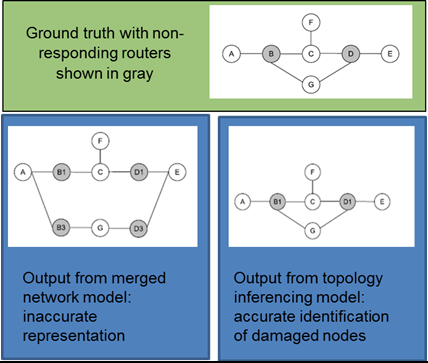Penn State Research Yields Recovery Strategies for Damaged Networks
Problem: In the event of a WMD attack on a network, information about network status is incomplete. In particular, information is missing about the damaged part of the network, making it necessary to construct network recovery strategies based on incomplete information. DTRA has been funding basic research on the use of inferencing techniques, including tomography based on partial information, to build full topologies.

A comparison of the output of a merged network model and that of the topology inferencing model developed under the DTRA-funded program showing the topology inferencing model more accurately identifies the damaged routers from incomplete information.
Results: Professor Thomas LaPorta of Penn State has demonstrated a method for inferring network topologies from partial information and baseline topology information gathered while the network was operating normally. He has used such topologies to construct network recovery schemes for networks with non-responding routers and unknown node status.
Potential: The methods developed under this program will allow rapid recovery from catastrophic network failures without needing to wait for full characterization of the damaged nodes.
Transition/Impact: The use of tomography to infer network topology has been transitioned to the Network and Information Sciences International Technology Alliance (ITA), a bilateral cooperative technology agreement between the Army Research Lab and the UK Ministry of Defense. The application being pursued under a 2-year program under ITA is for tactical hybrid wireless networks – that is, a network that exploits and interoperates with commercial wireless networks.
PHYSICAL NETWORKS PROTECTION & MODELING (TA-2)
HDTRA1-10-1-0085: STATE ESTIMATION AND OPTIMAL RECOVERY IN NETWORKS WITH MASSIVE CASCADING FAILURES
THOMAS LAPORTA, PENNSYLVANIA STATE UNIVERSITY